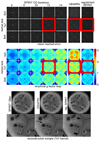SPIRiT: Iterative self-consistent parallel imaging reconstruction from arbitrary k-space
- PMID: 20665790
- PMCID: PMC2925465
- DOI: 10.1002/mrm.22428
SPIRiT: Iterative self-consistent parallel imaging reconstruction from arbitrary k-space
Abstract
A new approach to autocalibrating, coil-by-coil parallel imaging reconstruction, is presented. It is a generalized reconstruction framework based on self-consistency. The reconstruction problem is formulated as an optimization that yields the most consistent solution with the calibration and acquisition data. The approach is general and can accurately reconstruct images from arbitrary k-space sampling patterns. The formulation can flexibly incorporate additional image priors such as off-resonance correction and regularization terms that appear in compressed sensing. Several iterative strategies to solve the posed reconstruction problem in both image and k-space domain are presented. These are based on a projection over convex sets and conjugate gradient algorithms. Phantom and in vivo studies demonstrate efficient reconstructions from undersampled Cartesian and spiral trajectories. Reconstructions that include off-resonance correction and nonlinear l(1)-wavelet regularization are also demonstrated.
Figures









References
-
- Roemer PB, Edelstein WA, Hayes CE, Souza SP, Mueller OM. The NMR phased array. Magn Reson Med. 1990;16:192–225. - PubMed
-
- Kelton JR, Magin R, Wright SM. An algorithm for rapid image acquisition using multiple receiver coils; Proc., SMRM, 8th Annual Meeting; Amsterdam. 1989. p. 1172.
-
- Sodickson DK, Manning WJ. Simultaneous acquisition of spatial harmonics (SMASH): Fast imaging with radiofrequency coil arrays. Magn Reson Med. 1997;38:591–603. - PubMed
-
- Pruessmann KP, Weiger M, Scheidegger MB, Boesiger P. SENSE: Sensitivity encoding for fast MRI. Magn Reson Med. 1999;42:952–962. - PubMed
-
- Pruessmann KP, Weiger M, Börnert P, Boesiger P. Advances in sensitivity encoding with arbitrary k-space trajectories. Magn Reson Med. 2001;46:638–651. - PubMed
Publication types
MeSH terms
Grants and funding
LinkOut - more resources
Full Text Sources
Other Literature Sources
Medical

